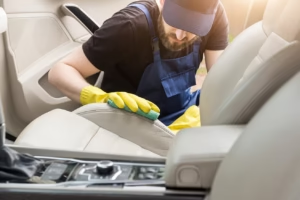Car seats take a beating—spilled coffee, muddy shoes, pet accidents, or that lingering fast-food smell can turn your interior into a mess. Professional detailing costs $50–$150, but you don’t need to break the bank or buy fancy cleaners. With everyday household products like vinegar, baking soda, and dish soap, you can erase stains and banish odors yourself. In this 2000+ word guide, I’ll walk you through every step of assessing and cleaning your car seats, with detailed explanations to make it simple and effective. By the end, your seats will look and smell fresh—all for pennies using stuff you already have at home.
Why Cleaning Car Seats Matters
Your car’s interior is like a second home—you spend hours in it, and it reflects your care. Stains not only look bad but can damage fabric or leather over time, while smells make every drive unpleasant. Whether it’s a soda spill, pet hair, or cigarette odor, leaving them unchecked lets grime sink deeper and odors cling harder.
Here’s why this DIY fix is worth it:
-
- Saves Cash: Professional cleaning is pricey—this costs under $5 with household staples.
-
- Freshens Up: Clean seats and no smells make your car feel new again.
-
- Protects Value: A spotless interior boosts resale or trade-in appeal.
-
- Health Bonus: Odors and stains can harbor bacteria—cleaning keeps it sanitary.
This guide covers fabric and leather seats (most cars have one or the other) using safe, household methods. Let’s roll up our sleeves and get started!
Tools and Materials You’ll Need
No need for specialty cleaners—just raid your kitchen and bathroom. Here’s a detailed list with explanations of why each item works and how you’ll use it:
-
- White Vinegar: An all-star cleaner—its acidity breaks down stains (coffee, grease) and neutralizes odors (smoke, pet smells). Grab a bottle from your pantry—$1 at most stores.
-
- Baking Soda: This powder absorbs odors and lifts stains with gentle abrasion. You’ll sprinkle it dry or mix it into a paste—cheap and versatile (under $1).
-
- Dish Soap: Cuts through grease and grime (think food spills). Any liquid dish soap works—Dawn’s a favorite for its strength. A few drops go far.
-
- Warm Water: Dilutes cleaners and activates them—tap water in a bowl or spray bottle does the trick.
-
- Spray Bottle: Mixes and applies solutions evenly—recycle an old cleaner bottle (rinse well) or buy one for $1. You’ll mist stains and odors with it.
-
- Microfiber Cloths or Rags: Soft and absorbent for scrubbing and wiping—won’t scratch leather or snag fabric. Old towels or T-shirts work too—grab 3–5.
-
- Soft-Bristle Brush: Loosens stubborn stains—a toothbrush or dish scrubber (soft side) is perfect. Avoid hard bristles—they tear fabric or mar leather.
-
- Vacuum Cleaner: Sucks up dry debris (crumbs, hair) before wet cleaning. A handheld or shop vac with an upholstery attachment is ideal—borrow if needed.
-
- Spoon or Butter Knife: Scoops excess spill solids (e.g., food) without spreading—any utensil works.
-
- Plastic Bags: Holds damp rags or trash—keeps your car tidy during the job.
-
- Safety Gear: Gloves (optional, for wet hands or vinegar smell), glasses (if splashing’s a worry), and a mask (for strong odors like smoke).
Optional Extras:
-
- Club Soda: Bubbles lift fresh stains (e.g., soda)—a $1 can from the fridge.
-
- Lemon Extract: Adds a fresh scent—mix a few drops into solutions (pantry staple).
-
- Fan or Hairdryer: Speeds drying—prevents mildew on fabric seats.
Cost? Under $5 if you’ve got these at home—way less than $50+ for pro detailing.
Preparation: Setting Up for Success
Before you start scrubbing, prep your car and supplies to avoid mess or mistakes:
-
- Park in a Good Spot: Choose a shaded area (garage, carport) or a cloudy day—sun bakes wet seats, risking mildew or leather cracks. Good light helps spot stains.
-
- Gather Your Supplies: Lay out everything—vinegar bottle, baking soda box, spray bottle, etc.—on a seat or the ground. Check amounts: half a cup of vinegar, a few tablespoons of baking soda, a squirt of soap—enough for both seats.
-
- Check Seat Material: Look at your seats—fabric (cloth, velour) or leather/vinyl? Fabric soaks up spills; leather resists but stains show. This guide adjusts for both—test solutions on a small spot first (e.g., under the seat).
-
- Wear Safety Gear: Slip on gloves if vinegar’s smell bugs you or hands get prune-y. Glasses protect from splashes; a mask helps with bad odors (e.g., smoke). Comfort keeps you focused.
Step-by-Step Guide to Removing Stains and Smells
We’ll assess the mess first, then clean step-by-step. This works for fabric and leather seats—fabric needs more drying care, leather more caution with water. Tackle one seat at a time.
Part 1: Assess the Stains and Smells
Know what you’re up against:
Step 1: Inspect the Seats
-
- Look Closely: Check each seat—spills (dark wet spots), stains (coffee rings, mud), or grime (greasy armrests). Sniff around—musty (mildew), sharp (urine), or stale (smoke)?
-
- Feel It: Run your hand over—sticky (soda), gritty (dirt), or damp (old spill)? Helps pick the right fix.
-
- What It Means: Fresh spills lift easier—act fast. Set stains or deep odors need more steps. Pet hair or crumbs? Vacuum first.
Part 2: Clean the Seats
Here’s how to zap stains and smells with household goodies:
Step 2: Remove Loose Debris
-
- Scrape Solids: For fresh spills (e.g., dropped burger), use a spoon or butter knife to scoop excess—gentle, don’t smear. Dump into a plastic bag.
-
- Vacuum Up: Run your vacuum with an upholstery attachment over the seat—sucks up crumbs, hair, dirt. Hit crevices and seams—takes 5 minutes per seat.
-
- Why It Matters: Wet cleaning over debris spreads mess—dry stuff goes first.
Step 3: Treat Stains
-
- Mix Solution: Fill a spray bottle with 1 cup warm water, 1/4 cup white vinegar, and a squirt of dish soap (1 tsp)—shake well. Vinegar breaks stains; soap cuts grease.
-
- Spot Test: Spray a hidden spot (under seat)—wait 5 minutes, wipe. No color fade or damage? Safe to use.
-
- Spray and Scrub: Mist the stain lightly—don’t soak fabric. Use a soft-bristle brush (toothbrush) to scrub in circles—firm but gentle, 2–3 minutes. Leather? Dab with a damp cloth, less scrubbing—too much water cracks it.
-
- Tough Stains: Mix baking soda and water into a paste (2 tbsp soda, 1 tbsp water). Dab on with a cloth, let sit 10 minutes, scrub off—lifts grease or ink.
-
- Why It Matters: Vinegar and soap dissolve stains; baking soda lifts stubborn ones—teamwork wins.
Step 4: Wipe and Rinse
-
- Wipe Off: Dampen a microfiber cloth with plain water—wipe away soap and loosened grime. Flip to a dry side—blot excess wet (fabric) or polish dry (leather).
-
- Check It: Stain gone? Move on. Still there? Repeat Step 3—patience pays.
-
- Why It Matters: Leftover soap dries sticky—clean water resets the surface.
Step 5: Tackle Odors
-
- Sprinkle Baking Soda: Dust a thin layer over the seat (1–2 tbsp)—focus on smelly spots (e.g., pet stains). Let sit 15–30 minutes—absorbs odors like a sponge.
-
- Vacuum Again: Suck up the baking soda—odor should fade. Strong smell? Mix 1/2 cup vinegar and 1/2 cup water in a spray bottle, mist lightly, let dry—neutralizes deep stink.
-
- Leather Care: Wipe with a vinegar-damp cloth (1:1 mix)—don’t soak—then dry fast. Avoid baking soda piles—it dries out leather.
-
- Why It Matters: Baking soda traps odors; vinegar kills the source—double whammy for freshness.
Step 6: Dry the Seats
-
- Blot Fabric: Press dry microfiber cloths into fabric—soaks up water. Open windows or use a fan/hairdryer (low heat)—dries in 1–2 hours. Wet too long? Mildew risk.
-
- Polish Leather: Wipe dry with a cloth—no standing water. Sun dries fast but avoid long exposure—cracks form.
-
- Why It Matters: Damp seats breed mold or damage—dry quick for safety.
Step 7: Final Clean and Check
-
- Wipe Down: Use a dry cloth—fabric should feel clean, leather smooth. No residue—good job!
-
- Sniff Test: Lean in—fresh or neutral? Lingering smell? Repeat odor step.
-
- Why It Matters: Ensures no grime or stink sneaks back—finishes the win.
Tips for a Fresh Finish
-
- Act Fast: Fresh spills lift easier—clean ASAP.
-
- Test First: New fabric/leather? Spot-test—avoids surprises.
-
- Repeat if Needed: Old stains take 2–3 rounds—don’t give up.
-
- Prevent: Seat covers or mats stop future messes—cheap protection.
Troubleshooting
-
- Stain Won’t Budge: Stronger paste—more baking soda, less water—sit longer (20 minutes).
-
- Smell Stays: Heavy vinegar spray (2:1 vinegar-water)—air out well.
-
- Fabric Soaked: Too much water—blot more, dry with fan.
Household Hacks (Quick Fixes)
-
- Club Soda: Pour on fresh soda spills—bubbles lift, blot dry.
-
- Lemon Juice: Dab on stains—lightens, smells nice—rinse after.




